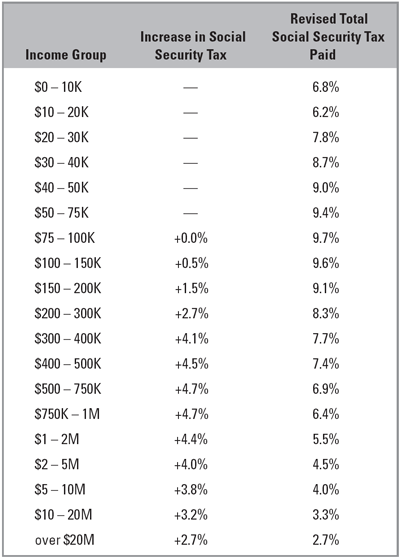
Go Ahead and Lift the Cap
Assessing a Campaign Flyer on Social Security
This article is from the March/April 2008 issue of Dollars & Sense: The Magazine of Economic Justice available at http://www.dollarsandsense.org

This article is from the March/April 2008 issue of Dollars & Sense magazine.
Subscribe Now
at a 30% discount.
Barack Obama. A plan with a trillion dollar tax increase on America's hard-working families. Lifting the cap on Social Security taxes to send more of Nevada families' hard-earned dollars to Washington. Senator Obama said, "I think that lifting the cap [on Social Security taxes] is probably going to be the best option."
Hillary Clinton. A blueprint to rebuild the road to middle-class prosperity. Provide tax relief for the middle class and address Social Security without putting burdens on hard-working families or seniors. Strengthen Social Security and the economy by returning to balanced budgets.
—Official campaign flyer distributed by Nevadans for Hillary, January 2008
Back in January, even before things got really nasty in the Democratic primary, Barack Obama and Hillary Clinton were already going after each other about taxes and Social Security.
The Clinton campaign sent a flyer to Nevada voters before that state's January 19 Democratic caucuses, accusing Obama of planning to impose "a trillion dollar tax increase on America's hard-working families" by lifting the cap on income subject to Social Security taxes. Clinton, the flyer claimed, does "not want to fix the problems of Social Security on the backs of middle-class families and seniors."
The truth was something different. First, Obama did not exactly propose removing the cap, currently $97,500. (In other words, employers and employees each pay a flat percentage of the first $97,500 of each employee's salary, but no tax on the income above that.) He did discuss adjusting it as "the best way to approach this [reforming Social Security]," preferable to either cutting benefits or increasing the retirement age, later adding that he would consider keeping the exemption from $97,500 to around $200,000, lifting it only for any income above $200,000.
More important, lifting the cap would in no way increase the tax burden on middle-income families. Just under 6% of U.S. wage earners make more than $97,500 in wages, so even removing the cap altogether would raise taxes only for that small group.
Now, there is a legitimate progressive objection to Obama's discussion of fixing Social Security by adjusting the cap: any talk of reforming Social Security inevitably plays into the hands of those out to privatize it by trumping up a phony crisis. But that hardly seems to be the point of the Clinton campaign flyer.
Too bad it wasn't. Clinton gets it: in the past she herself has warned that acting as if Social Security is in crisis is "a Republican trap." Yet last October, an Associated Press reporter overhead her telling an Iowa voter that she would consider lifting the cap on payroll taxes as long as wages between $97,500 and $200,000 remained exempt—precisely the proposal she derides in the Nevada flyer.
Inside Social Security
Let's remind ourselves that Social Security, which cut poverty rates among the elderly from 35% in 1960 to 9.4% in 2006, is no Robin Hood plan that robs the rich to pay for the retirement of the working class. Rather, it is a mildly redistributive public retirement program financed by contributions from the wages of working people. In fact, Social Security taxes fall far more heavily on the poor and working class than on the well-to-do. Payroll taxes are a fixed 12.4% (actually 6.2% on employees and 6.2% on employers); they are levied only on wage income, not on property income; and the cap on wages subject to the tax (the subject of the debate between Clinton and Obama) means that while most workers pay the tax on every dollar of their income, the highest earners pay it only on a part.
Even FDR acknowledged that relying on payroll contributions to finance Social Security was regressive, although he famously argued that with those contributions in place, "no damn politician can ever scrap my Social Security program."
George W. Bush's 2005 push to privatize Social Security only underscored FDR's point. Bush made more than 40 trips around the United States to stump for his plan, but fewer people supported Social Security privatization afterwards than before he started. Ironically enough, the only aspect of Social Security reform that has generated widespread support is lifting the cap: in a February 2005 Washington Post poll, 81% of respondents agreed that Americans should pay Social Security taxes on wages over the cap.
This is no radical or hare-brained idea. It has the endorsement of the AARP, the largest seniors' lobby. And there is a clear precedent. A similar cap used to apply to the payroll tax that funds Medicare, but a 1993 law removed that cap and now every dollar of wage income is taxed to pay for Medicare. It certainly does not warrant the derision heaped on it by the Clinton campaign or the unwillingness of the Obama campaign to embrace it. In fact, lifting the cap would rewrite this one rule to favor working people more—just what the Obama campaign claims to support.
Lifting the cap on Social Security taxes would raise a significant amount of revenue: $1.3 trillion dollars over ten years according to the libertarian Cato Institute, and $124 billon a year according to the left-of-center Citizens for Tax Justice. Long term, lifting the payroll tax cap would just about cover the shortfall Social Security will face if economic growth slows to a snail's pace in the decades ahead, as forecast by the Social Security Administration (SSA). (See The Social Security Administration's Cracked Crystal Ball, and Social Security Isn't Broken for critiques of the SSA's forecasts.) According to Stephen Goss, the SSA's chief actuary, lifting the cap while giving commensurate benefit hikes to high-income taxpayers once they retire would cover 93% of the SSA's projected shortfall in Social Security revenues over the next 75 years. Removing the cap without raising those benefits would actually produce a surplus in the system over the same period—even if the economy creeps along as the SSA predicts it will.
Finally, the combination of the cap and the unprecedented inequality of the last two decades has shrunk the Social Security tax base. Some 90% of wages fell below the cap in 1983. Today, with the increased concentration of income among the highest-paid, that figure is down to 84%—even as the number of workers with earnings above the cap has dropped. The cap would have to rise to $140,000 just to once again cover 90% of all wages; the additional revenues resulting from just this change would close about one-third of the long-term Social Security deficit projected by the SSA.
Effect of Removing the Earnings Cap on Social Security Taxes by Income Category
Resulting Social Security Tax Increase and Total Social Security Tax as Shares of Total Income in 2007.

Source: "An Analysis of Eliminating the Cap on Earnings Subject to the Social Security Tax & Related Issues," (Citizens for Tax Justice, 11/30/06).
Hardly Soaking the Rich
Making high earners pay the Social Security tax on all of their wage income, as low- and middle-income earners already have to, might not strike you as class warfare—but the high flyers sure think it is. Just listen to the financial establishment squeal. Investment Management chairman Robert Pozen, architect of the benefit-cutting proposal endorsed by the Bush administration (and deceptively labeled "progressive indexing"), warns that lifting the cap would represent "one of the greatest tax increases of all time" and "is so crazy it's beyond belief." The editors of the Wall Street Journal agreed. And the conservative Heritage Foundation ginned up numbers purporting to show that lifting the cap would impose a "massive 12.4 percentage point tax hike" that would return federal tax rates to levels not seen since the 1970s.
Just how wet would the rich get if the cap on Social Security taxes was lifted? The data suggest they would get damp, but hardly soaked.
For starters, lifting the cap affects just 5.9% of wage-earners. This group benefited massively from three rounds of Bush tax cuts, as evidenced by the fact that the effective federal tax rate (i.e., the share of income actually paid in federal taxes, once all deductions and exemptions have been taken) on the richest 5% of taxpayers fell from 31.1% in 2000 to 28.9% in 2005, according to the Congressional Budget Office.
So, lifting the wage cap on Social Secu-rity taxes would not do much more than reverse those tax giveaways to the wealthy. And the wealthiest taxpayers, those with incomes over $1 million, would still be paying a smaller portion of their income in payroll taxes than all other taxpayers. (See table.) For the top 5% of taxpayers, lifting the cap would push their effective federal tax rate up to 31.5%, a bit above where it was when Bush took office but still below the 31.8% level they paid back in 1979, before nearly three decades of pro-rich tax cutting. The top 1% would pay an effective federal tax rate of 33.8% —again, higher than it was in 2000 but still well below its 1979 level of 37.0%.
That is hardly soaking the rich. In any case they can afford it. The best-off 5% of households had an average income of $520,200 in 2005, some 81% higher than in 1979 after correcting for inflation. The richest 1%, with an average income of $1,558,500 in 2005, saw their after-tax income rise a whopping 176% over the same period.
Lifting the cap on payroll taxes would not only resolve any alleged crisis in Social Security, but also help to right the economic wrongs of the last few decades. And it is popular to boot. Isn't that an idea any progressive politician should seriously consider?
